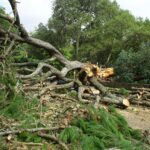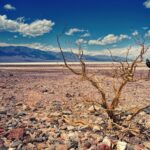At a glance
- Recognising potential hazards during tree trimming is crucial for ensuring safety and preventing accidents or injuries.
- Tree trimming hazards include falls from heights, contact with power lines, falling branches, improper equipment use, and encountering bee or insect nests.
- By following safety precautions, such as proper training, using appropriate equipment, and seeking professional assistance, individuals can mitigate risks and maintain a safe tree-trimming environment.
Tree trimming is an essential part of maintaining the health and aesthetics of our landscapes. However, it’s crucial to recognise and mitigate potential hazards associated with this task to ensure the safety of both workers and the surrounding environment. In this article, we will explore common hazards during tree trimming and provide valuable tips on how to avoid them with the help of an affordable tree service in Melbourne.
Importance of Recognising Potential Hazards During Tree Trimming
When it comes to tree trimming, safety should always be a top priority. Recognising potential hazards and taking appropriate precautions can significantly reduce the risk of accidents or injuries. Whether you are a homeowner attempting a DIY project or hiring professionals for an affordable tree service, being aware of potential hazards is vital.
Let’s look at some common hazards during tree trimming and how to avoid them effectively.
Falling from Heights
Working at heights poses a significant risk during tree trimming. Unstable branches, slippery surfaces, or improper ladder placement can lead to falls, causing severe injuries or even fatalities. To avoid such incidents:
- Always wear a safety harness and ensure it is properly secured to an appropriate anchor point.
- Inspect ladders for stability and position them on even ground, maintaining a safe angle. Before using a ladder, carefully inspect it for any damages or defects that could compromise its stability. Ensure the ladder is positioned on a flat and even surface to prevent it from wobbling or tipping over.
- Avoid working on windy days as it can make tree branches more unpredictable. Windy conditions can sway tree branches and become erratic, increasing the risk of debris falling.
- Receive proper training on working at heights and use platforms or aerial lifts when necessary.
Alternatively, seek professional help from a tree remover in Melbourne to avoid any potential hazards of tree trimming.
Contact with Power Lines
Contact with power lines is an extremely dangerous hazard during tree trimming. Electrocution and electrical fires are real risks if precautions are not taken seriously. To avoid power line accidents:
- Conduct a thorough site assessment before starting the trimming process to identify the proximity of power lines.
- Maintain a safe distance of at least 10 feet from power lines. This buffer zone allows for a margin of safety and reduces the chances of accidental contact. Contact the utility company for assistance if the work is closer than this. They can guide you on how to proceed safely or arrange for the power to be temporarily disconnected if necessary.
- Use non-conductive tools and equipment to minimise the risk of electrical conductivity. Non-conductive tools, such as fibreglass or wooden handles for pruning shears or pole saws, help minimise the risk of electrical conductivity.
- Train workers on electrical safety procedures and make sure they understand the importance of avoiding power lines.
Falling Branches or Limbs
The risk of falling branches or limbs is inherent in tree trimming. Failure to identify and address weak or dead branches can result in serious injuries. To prevent accidents from falling debris:
- Wear personal protective equipment (PPE) such as a hard hat, safety glasses, and sturdy gloves.
- Inspect trees for deadwood, signs of disease, or weakened branches before initiating the trimming process. Deadwood can easily break and fall unexpectedly, posing a significant hazard. Signs of disease, such as fungal growth or extensive decay, can weaken branches, making them prone to breaking.
- Remove branches in a controlled manner, starting from the outermost parts and working towards the trunk. This technique ensures that the tree’s weight distribution remains balanced and reduces the likelihood of large branches suddenly falling.
- Consider hiring professional arborists for complex tree-trimming tasks to ensure proper risk assessment and management.
Improper Use of Equipment
Improper use of equipment is a common hazard during tree trimming. If used without proper training or maintenance, chainsaws, ladders, and other tools can cause serious injuries. To mitigate risks:
- Ensure that all equipment used for tree trimming is in good working condition and properly maintained. Check chainsaws, ladders, ropes, and other tools to ensure they are in good working condition. Look for damage or wear and tear signs, such as frayed cords or dull blades.
- Provide comprehensive training to workers on equipment operation, including safety protocols and techniques. Emphasise the importance of following safety protocols, such as proper grip and posture, when operating machinery.
- Always wear appropriate safety gear, such as goggles, ear protection, and chainsaw chaps, when operating machinery. Personal protective equipment (PPE) protects workers from potential injuries during tree trimming.
- Regularly inspect and sharpen cutting tools to ensure they function efficiently and safely.
Bee, Wasp, or Insect Nests
Encountering bees, wasps, or insect nests can be hazardous during tree trimming, especially for individuals with allergies. Allergic reactions to insect stings can range from mild discomfort to life-threatening situations. To deal with this potential hazard:
- Before starting work, carefully inspect trees for any signs of insect activity or nests.
- If nests are identified, it is advisable to contact professional beekeepers or pest control services for safe removal.
- If removal is not necessary or possible, cordon off the area and work at a safe distance from the nest.
- Wear protective clothing, such as bee suits or beekeeper veils, to minimise the risk of stings or bites.
- If the presence of an insect nest is confirmed, consider postponing the tree trimming until professionals safely remove the nest.
Conclusion
Recognising potential hazards during tree trimming is crucial for ensuring the safety of workers and the surrounding environment. We can significantly reduce the risk of accidents and injuries by addressing hazards such as falls from heights, power line contact, falling branches, improper equipment use, and insect nests. Whether you are a homeowner or seeking an affordable tree service in Melbourne, prioritise safety by following these guidelines and, when necessary, enlist the expertise of professional arborists. Remember, a safe tree-trimming experience is a rewarding one for everyone involved.
If you are looking for tree trimming services, consider availing the services of a professional tree remover in Melbourne for safety and accuracy. Hiring professional tree removers brings numerous benefits, including expertise, adherence to safety protocols, access to specialised equipment, knowledge of local regulations, insurance coverage, and efficient cleanup. Choosing professionals for tree removal ensures the task is carried out safely, efficiently, and with minimal impact on the surrounding environment.





